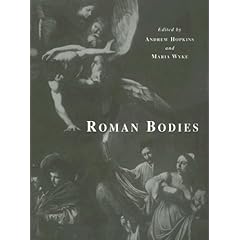
While I was researching other works published by The British School in Rome, I came across a listing for this fascinating-sounding book, Roman Bodies. Antiquity to the Eighteenth Century, edited by Andrew Hopkins and Maria Wyke:
"The seventeen wide-ranging and interdisciplinary essays explore dramatic changes in Western conceptions of the body. Divided into three sections, ‘Empire’, ‘Church’ and ‘Religion and science’, topics discussed include gender, sexuality, social and political identity, health and sickness, the body in death and after, and corporeal aesthetics.
[1] The body of Rome: introduction, Maria Wyke and Andrew Hopkins; [2] Archetypally Roman? Representing Seneca’s ageing body, Catharine Edwards; [3] Circumcision, de-circumcision and self-image: Celsus’s ‘operation on the penis’, Ralph Jackson; [4] A Roman perspective on circumcision, Pierre Cordier; [5] In the foreskin of your flesh’: the pure male body in late antiquity, Gillian Clark; [6] Headhunters of the Roman army, Nic Fields; [7] Execution in effigy: severed heads and decapitated statues in Imperial Rome, Eric R. Varner; [8] Disabled bodies: the (mis)representation of the lame in antiquity and their reappearance in early Christian and medieval art, Livio Pestilli; [9]Truth, perception and the pagan body in the Roman martyr narratives, Kristina Sessa; [10] The paradoxical body of Saint Agnes, Lucy Grig; [11] The relic translations of Paschal I: transforming city and cult, Caroline Goodson; [12] Majesty and mortality: attitudes towards the corpse in papal funeral ceremonies, Minou Schraven; [13] A theatre of cruelty and forgiveness: dissection, institutions and the moral discourse of anatomy in sixteenth-century Rome, Andrea Carlino; [14] Not torments, but delights: Antonio Gallonio’s Trattato de gli instrumenti di martirio of 1591 and its illustrations, Opher Mansour; [15] Ancient bodies and contested identities in the English College martyrdom cycle, Rome, Richard L. Williams; [16] Secrets of the heart: the role of saintly bodies in the medical discourse of Counter-Reformation Rome, Catrien Santing; [17] Contesting the Sacred Heart of Jesus in late eighteenth-century Rome, Jon L. Seydl."
I thought the sections on executions in effigy and the decapitation of statues in Roman art as well as the discussion of the misrepresentation of the disabled in antiquity sounded particularly interesting.
No comments:
Post a Comment